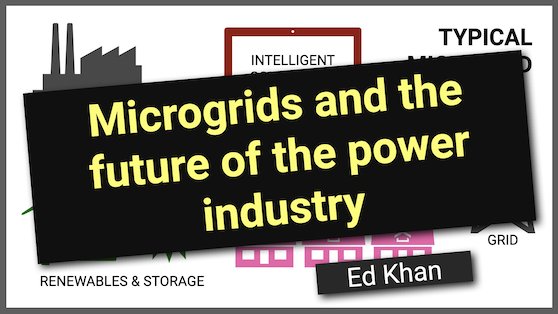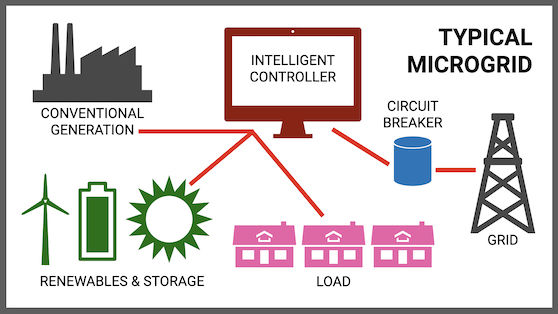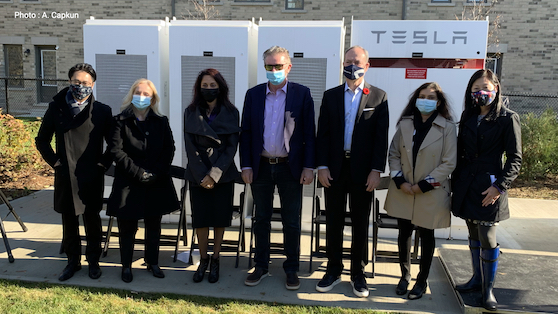
Features
Articles
Energy & Power
Renewables
Transmission & Distribution
Microgrids and the future of the power industry
January 10, 2022 | By Ed Khan

January 10, 2022 – The need for cleaner, more reliable energy has never been more urgent. Climate change is reeling in a record-breaking number of extreme weather events, such as major heat waves, droughts and ice storms, that are straining the power grid and proving the case for renewables.
Meantime, both emissions and the use of electric power are up 5% over pre-pandemic levels.
Not surprisingly, the demand for diversified energy sources is growing, along with a focus on sustainability and resiliency. For these reasons, microgrids are increasingly gaining industry attention. Understanding the advantages and components of these self-sustaining systems puts you in a better position to leverage them in your own operations.
Brief history: It all started with Edison
Microgrids are not a new concept. In fact, Thomas Edison’s first commercial power plant in 1882 was a direct current microgrid. The self-contained Pearl Street Station supplied electricity to a small area of lower Manhattan, and even included batteries to provide energy storage. Over time, these early microgrids began to merge, and the utilities that followed Edison connected to one another to form today’s electric grid.
The idea of using smaller grids to cater to the power needs of specific groups—a shopping centre or subdivision, universities, prisons, wind and solar power operations, and more—has become popular over the past few years given the rise in grid disruptions.
By essentially creating their own mini electric grid comprising of solar, wind, or other renewables, microgrids provide these applications with access to reliable power, thereby avoiding prolonged outages.
Microgrids’ main benefits
The biggest benefit of the self-sustaining microgrid is uninterrupted power. Microgrids can disconnect from the main grid and continually operate during an outage, much like a home with a backup generator.
The microgrid can also serve as an alternate source of energy during overload conditions within the main grid. For instance, the battery within a microgrid is a DC source that can be converted to an alternating current source to shift power back to the main grid when needed.
Microgrids also positively impact the environment because of their ability to incorporate renewable energy (and balance generation between these sources and non-renewables), thereby reducing overall GHG emissions. These small grids also drive cost savings and energy efficiency because they make use of onsite energy, and less energy is lost through transmission.
Key components of microgrids

A microgrid is designed with all the necessary elements to operate independently of the main grid, including generation, storage, and demand. These components—which can incorporate electrical or thermal energy—are confined within a bounded and controlled network.
Generation sources could include controllable, fuel-based sources such as coal, nuclear, natural gas, or hydrogen. These sources could also include non-controllable, weather-dependent generation, such as solar or wind power. Backup generators, uninterruptable power supplies (UPSs), and rechargeable energy storage (e.g. gravity or chemical batteries) are also options.
Energy storage typically consists of battery arrays and pumped hydro energy. Adding storage to the microgrid significantly enhances its ability to manage the unpredictability of renewable energy. The battery can charge during the day when the sun is shining and store the energy for discharge in the evening when solar panels aren’t generating anything. The batteries can also supply power back to the grid when called upon.
Microgrids connect to the main grid through a Point of Common Coupling (PCC), which imports and exports electricity as needed. A micromanager sits at the centre and balances generation against load. Control systems within the microgrid are critical for monitoring demand and effectively matching supply.
There are many different types of microgrids. Those that are grid-connected have a physical connection to the utility grid via a switching mechanism at the PCC. Networked microgrids consist of several separate distributed energy resources (DERs) or microgrids connected to the same utility grid circuit segment and serve a wide area. These are usually managed by SCADA systems.
Remote microgrids are physically isolated from the utility grid and always operate on island mode due to a lack of nearby transmission and distribution infrastructure.
Role of emerging technology
Artificial intelligence (AI) is quickly becoming the ‘brain’ of the microgrid. AI improves the forecasting of energy supply and demand variations within the microgrid’s boundaries and can optimize distribution in real time. The most effective use of AI is when the microgrid consists of weather-/time of day-dependent sources along with conventional power sources, such as diesel-driven or combustion turbine generators.
Microgrids allow for load and generation flexibility and can exchange energy with the main grid to provide the customer with the lowest cost of energy. When different types of energy sources (e.g. solar, wind, hydropower) are available and connected—and overall power demand is low—intelligent software and AI will work out the sequence of dispatching sources with the aim of reducing the overall cost of energy.
The technology can instruct the microgrid to start charging the battery storage system to absorb excess energy instead of turning on loads later when the cost of energy is higher. The AI and advanced technology take patterns of energy usage, weather conditions, and other utility information into consideration when making these types of decisions. AI also gives utilities more effective control over microgrid operations.
As utilities adopt software and connect operations to the internet, microgrid cybersecurity becomes a top priority. Attacks on critical infrastructure are rising, and protecting against these threats in the microgrid is just as urgent as addressing them in conventional power grid operations. Microgrids are relied on to deliver power during crisis. Factoring cybersecurity into microgrid operations is key for ensuring these systems hold up when they’re needed most.
Four things to consider with microgrids
As you factor microgrids into your power operations, there are several things to keep in mind:
1. Be mindful of harmonics
Unlike conventional generators, microgrids produce harmonics. While leveraging onsite renewables is critical for reducing the environmental impact of power grid operations, it can worsen harmonics injections.
These injections distort normal currents in the grid and create higher voltage levels, potential harmonic resonances and dangerous temperatures within transformers, cables and other electrical equipment. The heat associated with harmonics can cause severe damage and impact performance, but this issue can be mitigated by correctly applying appropriate filtering.
IEEE Guide 519 “Recommended practice and requirements for harmonic control in electric power systems” specifies harmonic limits, and is a good tool for utility and industrial companies looking to contain harmonic injections with filtering.
The International Electrotechnical Commission (IEC) also provides guidance, imposing restrictions on equipment that produce harmonic currents. Under IEC, it is the responsibility of the equipment manufacturer to limit the generation of harmonics.
Either way, the issue of harmonics needs your attention.
2. Relay protection is different for microgrids
There are notable limitations with conventional protection schemes when it comes to microgrids, which feature bi-directional fault current flow. Based on simple overcurrent relays, the coordination between protective relay devices (including 480/277V) is difficult in microgrids due to inadequate short circuit currents. While conventional generating sources provide short circuits that allow effective relaying, microgrids don’t provide the right magnitude or time duration of fault current.
Protective schemes also require adaptive relaying coupled with communications links between various protective devices. It’s often helpful to use protection devices compliant with IEC 61850 “Communication networks and systems for power utility automation” and protection implemented based on IEC 61850 GOOSE messaging (generic object-oriented substation event).
Furthermore, the use of differential relaying for transformers and lines will help provide well-coordinated systems with the required level of selectivity.
3. Research on microgrids is still ongoing
Microgrids don’t possess the required inertia that comes from heavy equipment, such as steam or gas turbines, to support system stability. This can lead to power quality issues and susceptibility to out-of-step conditions. Then there’s also the fact that self-sustaining grids (especially those that leverage renewable sources) don’t provide adequate short circuit currents.
But these issues are being addressed. Studies are being conducted around enhancing the converters applied at renewable generation.
4. Keep the specific situation top of mind
Microgrids are valuable because they can keep supplying power to assigned loads when the main grid is down during a storm. When the microgrid coverage area includes overhead distribution lines, this benefit may not be realized. Underground distribution can help with this issue.
Outlook is bright for microgrids
Microgrid developments continue to gain momentum. The first-of-its-kind microgrid built into a solar power plant is going online in Vermont, and will keep nearby homes from losing power during severe weather.
The 27-unit Altona Towns (Pickering, Ont.) recently celebrated the distinction of becoming one of Canada’s first pre-planned, nested microgrid residential communities.

The 27-unit Altona Towns (Pickering, Ont.) recently celebrated the distinction of becoming one of Canada’s first pre-planned, nested microgrid residential communities.
Microgrids sit at the centre of the clean and renewable energy movement. They strengthen the traditional grid and play a key role in ensuring that disturbances in the grid do not impact the continuity of power to the local load. These smaller grids help pave the way toward cleaner, dependable and secure sources of energy.
Ed Khan is the director, Protection Training and R&D, at Doble Engineering. He has over 35 years of power grid and engineering experience, and brings in-depth product and industry knowledge on relay protection and overall substation asset management. He received his Master degree in Power Systems from Texas A&M University.
This feature—plus more great content—also appears in the February 2022 edition of Electrical Business Magazine. Back issues are located in our Digital Archive.
Print this page